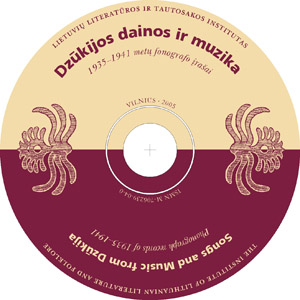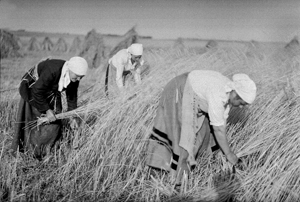 |
|
|
 |
Songs and Music from Dzūkija. Phonograph records of 1935–1941. Edited by Austė Nakienė and Rūta Žarskienė. Sound restoration by Skirmantas Sasnauskas. 44 records and transcription of melodies, 36 texts, 33 photos, the article. Vilnius: Institute of Lithuanian Literature and Folklore, 2005, 126 P. ISMN M-706239-06-4.
This publication finishes a series of CDs, in which the records of traditional music from the four Lithuanian ethnographic regions have been presented.
In Southern Lithuania – Dzūkija the olden way of life was observed up until the middle of the 20th century. In villages settled amongst the woods a cyclical understanding of time still existed. That is why the idea of the everlasting round of the calendar year was chosen for the composition of the CD. At the beginning of the CD melodies of calendar festivals and harvest time are presented, in the middle of the CD – wedding melodies and final melodies of the CD include songs, chants and laments that were performed at christening parties and funerals. Vocal tunes were accompanied by instrumental ones that sounded at the most important moments of the life of nature and of a human being.
At the time of winter festivals the Advent songs were sung and wedding games were played in villages of Dzūkija. The choice of the bride was glorified in these games. Traditional Christmas songs were linked with the custom of visiting neighbours. In them the miracle of the winter solstice were depicted by using archaic symbols and solemn regards were told to the hosts.
In a subtle way songs for the reaping of the rye were tuned to the rhythm of the nature. According to performers some melodies sounded in the field of the rye in the morning and in the middle of the day and ultimately different tunes – in the evening, at the sunset. Songs that sounded in the fields were performed in sonorous voices in order to be heard from for away. It is interesting that rye reaping songs were performed in loud voices at the Lithuanian Folklore Archive despite the fact that the recordings were made in the small premises.
The singing style of region was monody. Melodies of Dzūkija distinguish themselves by their perfect linear expression, plastic melodic lines, various modes and melismas.
Up to the World War I the fiddle took a part of the king at weddings, christenings and other festivals in Dzūkija. In ancient weddings every group whether that of a bride or a bridegroom had its own musician; when the groups got together the ensemble of the two or sometimes of the three fiddlers occurred. In the interwar period the fiddle was more and more pushed by modern musical instruments – guitar, dulcimer, German and later Russian accordion.
Some melodies performed on the fiddle and recorded on phonograph disks show a scanty number of doubled notes, seldom a free string is touched. The similar style of performing could be traced in the compositions that are played on dulcimer: tunes are performed monodically or with thirds and quints. The young country musicians intending not to be out of time endeavoured to play on new musical instruments, their inventiveness was also expressed in the search for new performing styles. Therefore one can hear the dances played on bayan (Russian-style accordion) and the singing with accompaniment of fiddle in this CD.
In the 4th decade of the 20th century the Lithuanian countryside became more and more modern. Educated people were concerned about the total extinction of folk art and began to organize the festivals called Ancient Days. The first Ancient Day took place in the town of Merkinė (1935). Some more festivals were organized in Alytus (1936), Daugai (1937) and Seirijai (1938). As a great attraction appeared the wedding party performance presented in Daugai. Regrettably, the performance of wedding recorded on the phonograph is of pure condition, therefore only a short part of the performance is selected.
In the CD the recordings of Pranciška Blažauskienė, Ona Grigaliūnienė, Emilija Ivoškienė, Ona Pigagienė, Katrė Šilanskienė, Adomas Kamendulis, Juozas Krušna, Kostantas Lukoševičius, Balys Valenta, and others are presented. In the book „Songs and Music form Dzūkija“ texts, music sheets, photographs of performers, and artworks by Kazys Šimonis are published.
© 2004 Lietuvių literatūros ir tautosakos institutas
|
|
|
 |



Harvest time in Viltininkai village.
Foto by Zenonas Slaviūnas, 1939.
|